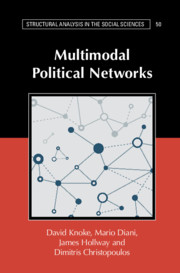Book contents
- Frontmatter
- Contents
- Figures
- Tables
- Preface
- 1 Politics, Communities, and Power
- 2 Multimodal Graphs and Matrices
- 3 Agency, Influence, Power
- 4 Political Communities in a Policy Network
- 5 Individuals in Associations
- 6 Agents and Events in Collective Action Fields
- 7 Nations Trading and Fighting
- 8 Legislative Influence
- 9 The Potential of Multimodal Political Networks
- Appendices
- References
- Index
5 - Individuals in Associations
Structuring Civil Society
Published online by Cambridge University Press: 12 May 2021
- Frontmatter
- Contents
- Figures
- Tables
- Preface
- 1 Politics, Communities, and Power
- 2 Multimodal Graphs and Matrices
- 3 Agency, Influence, Power
- 4 Political Communities in a Policy Network
- 5 Individuals in Associations
- 6 Agents and Events in Collective Action Fields
- 7 Nations Trading and Fighting
- 8 Legislative Influence
- 9 The Potential of Multimodal Political Networks
- Appendices
- References
- Index
Summary
Chapter 5 identifies the participation and roles of individuals in civil society. We argue that concentrating only on individuals would be more taxing and less meaningful than a multimodal analysis of interactions between individuals and associations in collective action fields. Individuals’ overlapping memberships allow organizations to monitor their environment, allocate resources, communicate, ally with others, and define the boundaries of their actions. At the same time, organizations enable individuals to meet similar others, strengthen their collective identity, share their skills and experiences, deal with threats, explore opportunities, and develop individual identities. We demonstrate how to use data on individual participation from the European Values Survey to conduct a relational, comparative analysis of the structure of political communities. Although multiple membership data are often employed to classify organizational types, here we investigate the structure and roles of the actors involved using projection and structurally equivalent blockmodeling. We examine networks of individuals and organizations in Italy, the UK, and Germany in 1990 and 2008 for a rich, comparative design that reveals the different profiles of political communities in those three countries.
- Type
- Chapter
- Information
- Multimodal Political Networks , pp. 93 - 133Publisher: Cambridge University PressPrint publication year: 2021

